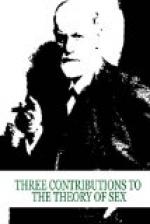[16] Further investigations lead to the conclusion that I. Bloch has overestimated the factor of excitement-hunger (Reizhunger). The various roads upon which the libido moves behave to each other from the very beginning like communicating pipes; the factor of collateral streaming must also be considered.
[17] This weakness corresponds to the constitutional predisposition. The early sexual intimidation which pushes the person away from the normal sexual aim and urges him to seek a substitute, has been demonstrated by psychoanalysis, as an accidental determinant.
[18] The shoe or slipper is accordingly a symbol for the female genitals.
[19] Psychoanalysis has filled up the gap in the understanding of fetichisms by showing that the selection of the fetich depends on a coprophilic smell-desire which has been lost by repression. Feet and hair are strong smelling objects which are raised to fetiches after the renouncing of the now unpleasant sensation of smell. Accordingly, only the filthy and ill-smelling foot is the sexual object in the perversion which corresponds to the foot fetichism. Another contribution to the explanation of the fetichistic preference of the foot is found in the Infantile Sexual Theories (see later). The foot replaces the penis which is so much missed in the woman. In some cases of foot fetichism it could be shown that the desire for looking originally directed to the genitals, which wished to reach its object from below, was stopped on the way by prohibition and repression, and therefore adhered to the foot or shoe as a fetich. In conformity with infantile expectation, the female genital was hereby imagined as a male genital.
[20] I have no doubt that the conception of the “beautiful” is rooted in the soil of sexual excitement and originally signified the sexual excitant. The more remarkable, therefore, is the fact that the genitals, the sight of which provokes the greatest sexual excitement, can really never be considered “beautiful.”
[21] Cf. here the later communication on the pregenital phases of the sexual development, in which this view is confirmed. See below, “Ambivalence.”
[22] Instead of substantiating this statement by many examples I will merely cite Havelock Ellis (The Sexual Impulse, 1903): “All known cases of sadism and masochism, even those cited by v. Krafft-Ebing, always show (as has already been shown by Colin, Scott, and Fere) traces of both groups of manifestations in the same individual.”
[23] On the other hand the restricting forces of the sexual evolution—disgust, shame, morality—must also be looked upon as historic precipitates of the outer inhibitions which the sexual impulse experienced in the psychogenesis of humanity. One can observe that they appear in their time during the development of the individual almost spontaneously at the call of education and influence.
[24] Studien ueber Hysterie, 1895, J. Breuer tells of the patient on whom he first practiced the cathartic method: “The sexual factor was surprisingly undeveloped.”




